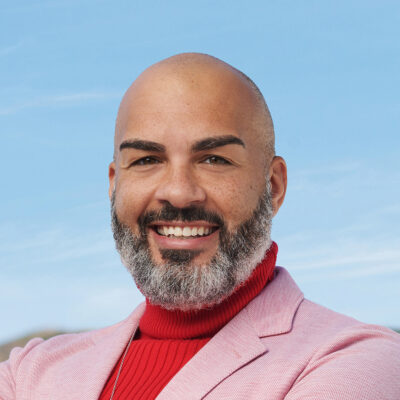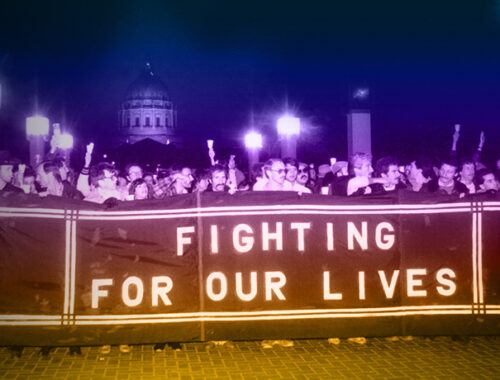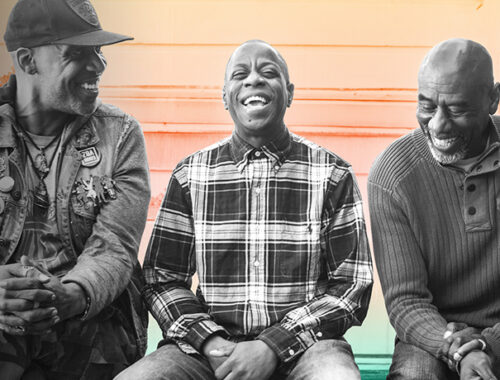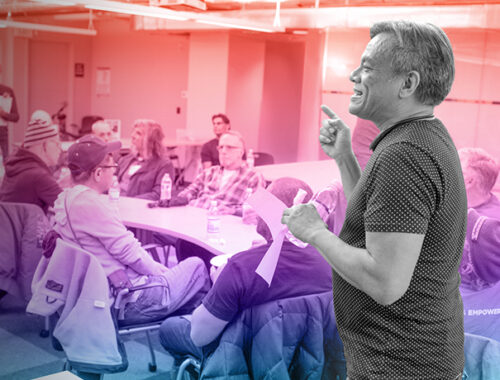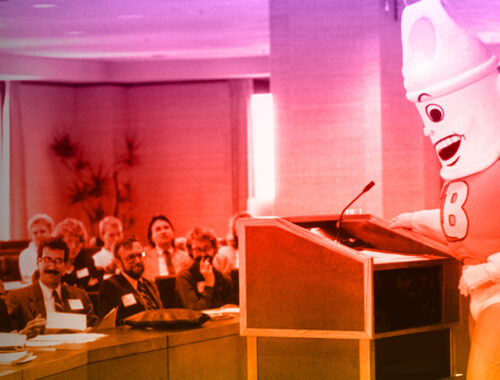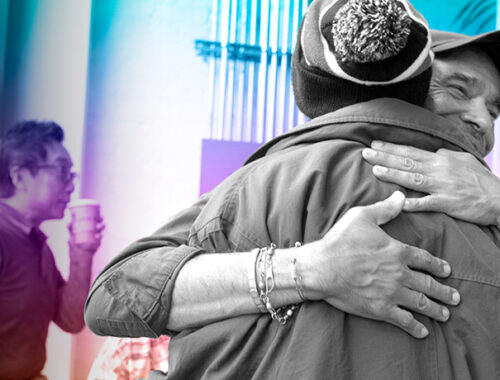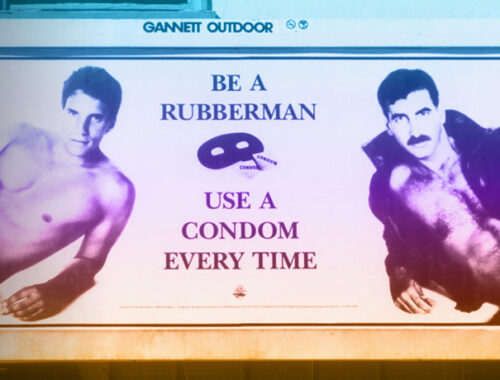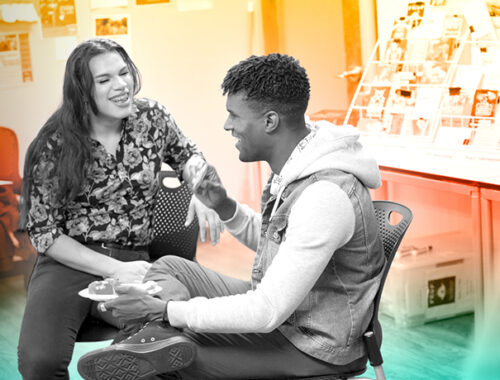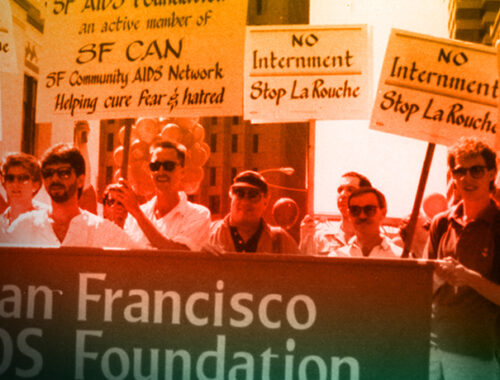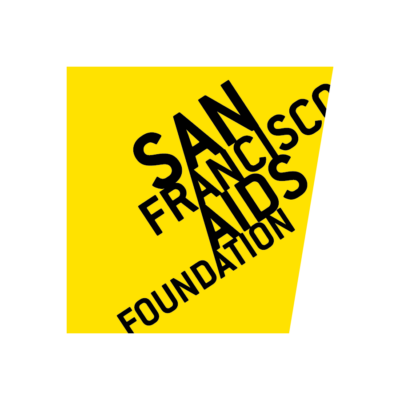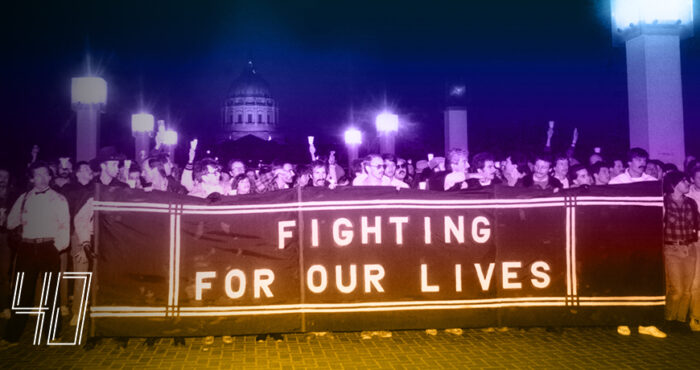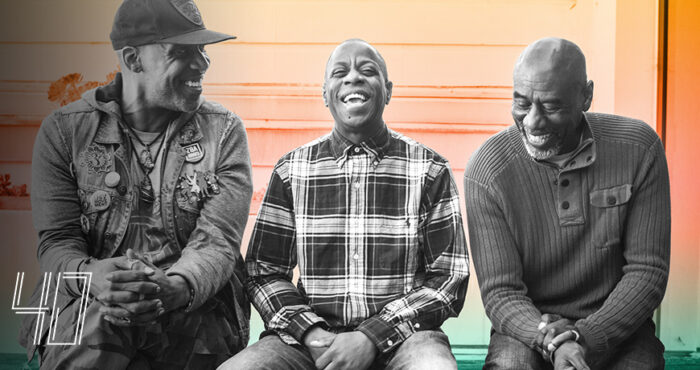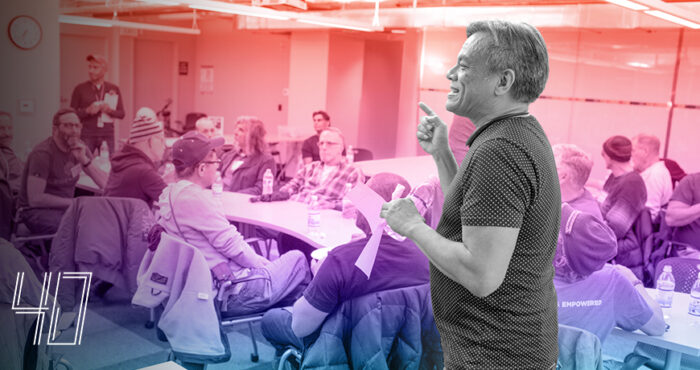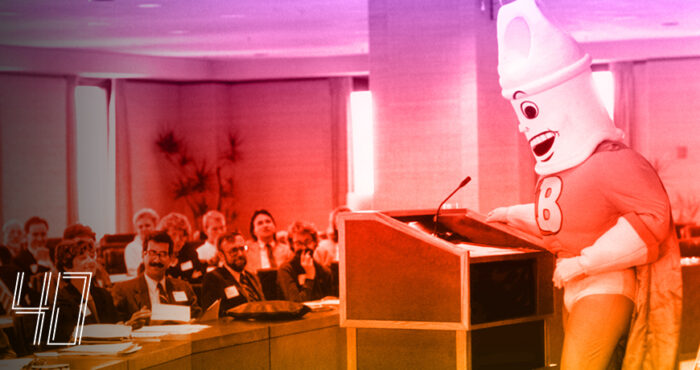From gay men to queer BIPOC folx and beyond
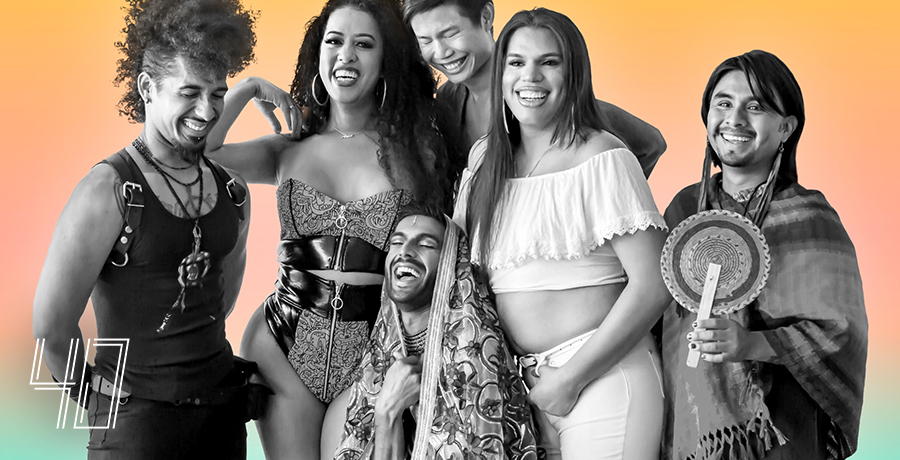
This article was produced in honor of San Francisco AIDS Foundation’s 40th anniversary, which we are commemorating in 2022.
As HIV and AIDS first began to rock San Francisco and the nation, what the media disparagingly called the “gay plague” led communities of gay men and their allies to come together to support lovers, friends, and partners. And indeed, San Francisco AIDS Foundation’s founders and first volunteers came from this community of gay men and their supporters scared for their own lives and those of their loved ones. But as the realization that HIV was rippling across other communities, SFAF responded–and continues to respond–by serving other communities in addition to gay men. Now, SFAF serves around 25,000 clients from the Bay Area every year.
Questions about who SFAF prioritizes–and what communities are served by our institution–are not new. Although our current strategic plan clearly centers a number of intersectional communities, we look back at our history with humility. As we move forward, we will keep our focus on racial justice, health equity, and the need to confront disparities in HIV wherever they appear.
Black Brothers Esteem
One of San Francisco AIDS Foundation’s longest-lived and most well-loved programs was created more than 25 years ago in response to the lack of services for Black gay men in San Francisco’s Tenderloin and South of Market neighborhoods. Black Brothers Esteem, known as BBE, provided a safe space for the men and trans women who attended the group to get support around HIV, sex and dating, substance use issues, and more.
This shift, to prioritize Black gay and same gender-loving men in the HIV response, was significant, and critical in a city where for the first time, the rate of infections among Black men surpassed that of white men.
“We had programs prior to that for gay and bi men regardless of race, but BBE was the first to be created for gay, bisexual, and same gender-loving men who were Black,” said Jamal Bey, the first program manager of BBE. “You can’t tell the story of San Francisco AIDS Foundation without telling the story of BBE.”
“BBE was founded at a pivotal time in the history of HIV,” said Bey. “It was right around the time when protease inhibitors came out, so people went from taking lots of pills to starting triple combination therapy. People were still talking about and worried about Magic Johnson’s HIV status. The HIV prevention director at the time really wanted a place where Black men could come together and really talk about risk, and other things that were important to them.”
Over the years, BBE members, volunteers, and staff “took the program to a new level,” said Bey. They offered evidence-based HIV prevention programs to the group, added a “Leadership Institute,” and worked with SFAF’s HIV Advocacy Network to advocate for HIV funding at AIDS Watch in Washington D.C. In the early 2000s, the group advocated San Francisco Pride for the first African American stage. Current-day BBE members participate in book clubs, social support groups, game nights, and advocacy and community events.
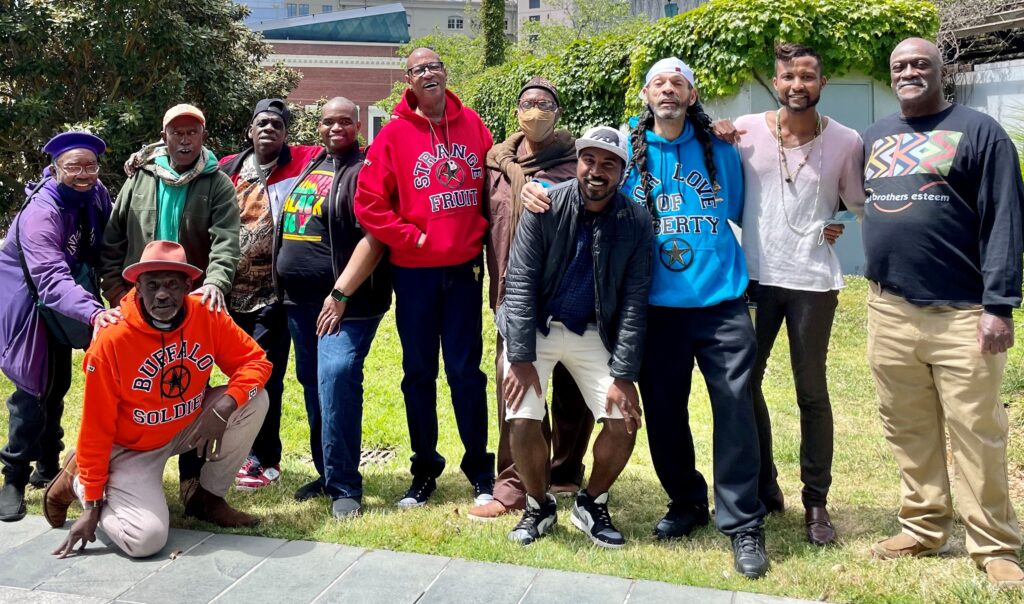
Preston Vargas, PhD, the director of Black Health at SFAF, said he has seen a shift in the group in recent years as movements such as Black Lives Matter have pushed the world into a greater consciousness about race and equity.
“For so long, there was a really deep value in naming issues of race and oppression, because the world left them unnamed,” he said. “But as the world’s consciousness has been evolving to recognize the realities for Black folks, BBE participants have started making choices to move out of that wounding. They want to know, ‘How can I move beyond the wounds that have happened to me, and manifest or actualize more healing in the community?’ We’re still very aware of the wounds of the AIDS epidemic, racial injustice, and marginalization, but it’s no longer a block. We’re re-authoring who we are in the world, and not just envisioning a future we’ve never had, but knowing and acting as if it’s possible.”
Women, femmes, non-binary folx, and transgender communities
The sheer number of people touched by HIV and AIDS over the course of San Francisco’s history has overwhelmingly been male, and in large part gay, bi and queer men. Yet cis and trans women, femmes, non-binary folx, and others along the gender spectrum have also been affected.
Over the years, SFAF has served women, femmes, non-binary folx, and trans communities through harm reduction work, health education initiatives, linkages to HIV care, and social support programming.
Since the beginning of the epidemic, SFAF has shared information about “women and AIDS,” but it wasn’t until the establishment of the Women’s Services Program in 1988 that the organization specifically developed services tailored for women and femmes. (And, our history archive shows that staff at SFAF helped consult on the script for “Midnight Caller” on NBC, when the show depicted TV’s first woman character with AIDS. Our executive director at the time, Pat Christen, went to LA to meet the producers and script writer for the show.)
Christen, who served as Executive Director from 1989 to 2004, recalled that as the demographics of the epidemic shifted, SFAF shifted services in response.
“By 1989, we revamped the Social Services Department to help ensure it would be responsive to the diversity of individuals coming through our doors–arriving from all over the country– including an increasing number of women. There was never a large number of women in San Francisco that had HIV, but we certainly wanted to make sure that those women who were at risk or living with HIV would be seen and would receive services designed to address their needs respectfully,” said Christen.
Christen added that services for people with AIDS were not based on means of infection.
“We weren’t asking people, ‘How did you get infected?’ before offering services,” said Christen. “We were asking, ‘If you need services, how can we be supportive?’”
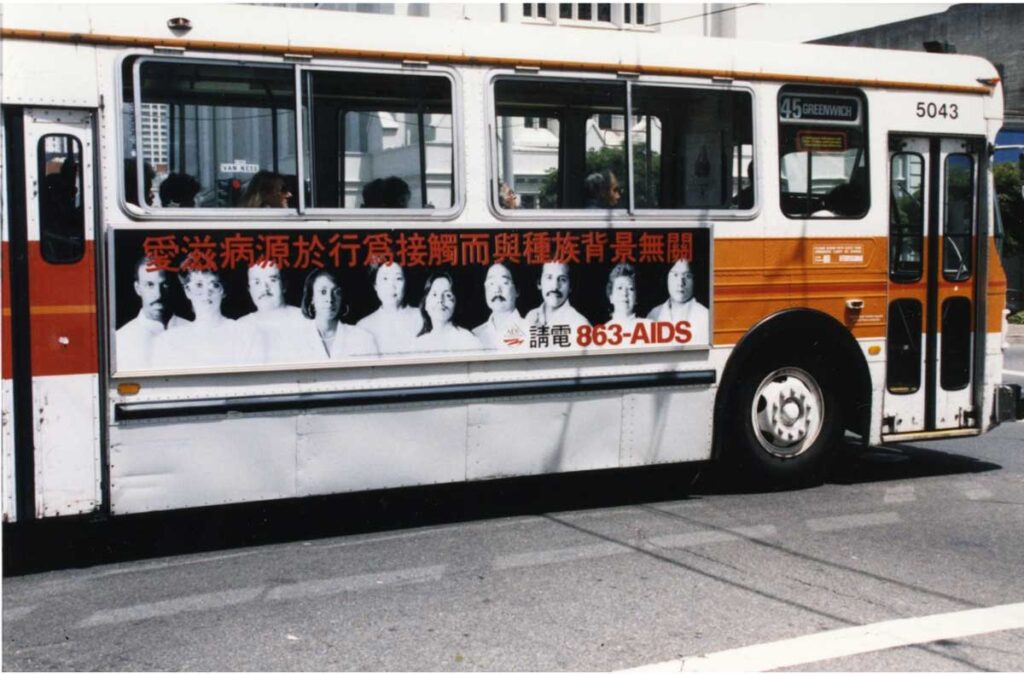
It wasn’t until 2015, with the founding of TransLife, that SFAF created space specifically for trans and non-binary members to come together and support each on issues related to sexual health, gender-affirming care, sex work, and stigma. The group was co-founded with Ms. Billie Cooper, a Black trans activist who has been living with HIV since the 1980s.
She remembers first seeking services at SFAF in the 1980s, only to find that there were limited services for Black trans people.
“I recognized that my sisters were also dying of this HIV virus just like the boys in the Castro but we weren’t getting services. I had to take care of my sistas who were also battling the virus,” she told Hank Trout in an article for A&U.
“I would say that there has been some indifference toward the trans community in San Francisco historically, and more of a focus on men who have sex with men, said Toni Newman, who is currently the interim CEO for Black AIDS Institute, and previously the executive director of St. James Infirmary in San Francisco. “Do I think that–specifically–Black and Latin trans women, and other trans women of color have been affected? I absolutely do. Probably 75% of the trans women of color I know are HIV-positive, so there must be more of a focus there.”
Newman said that in more recent years, she had noticed a shift in community organizations focusing on trans women. “It wasn’t just about providing services, it was about providing jobs. Hiring trans women as frontline staff, giving them a steady paycheck and job security,” she said.
In recent years, SFAF has revised its designation of Strut–the health center in the Castro–from a place for “gay and bi men” to be welcoming of people across the gender and sexual identity spectrums. Now, through our Trans Care program at Strut, transgender, non-binary and gender exapnsive folx can find a variety of gender affirming services including sexual health care, hormones, and more.
Art and performance bring new communities to Strut
“I remember years ago, when I was first hired, being asked how to bring different communities to Strut,” said Baruch Porras-Hernandez, the community events manager at SFAF. “I just said, ‘Well, I think you just need to ask people politely! Invite them, and give them a reason to come in.’”
That is exactly what Porras-Hernandez set out to do, by intentionally curating a variety of events and performances in collaboration with local performers and artists. Every month (pre-pandemic), Strut holds an art exhibit opening night showcasing the work of a Queer artist, and also holds a variety of free art, music, comedy, and learning events. During the COVID-19 pandemic, many of these events continued to be held virtually.
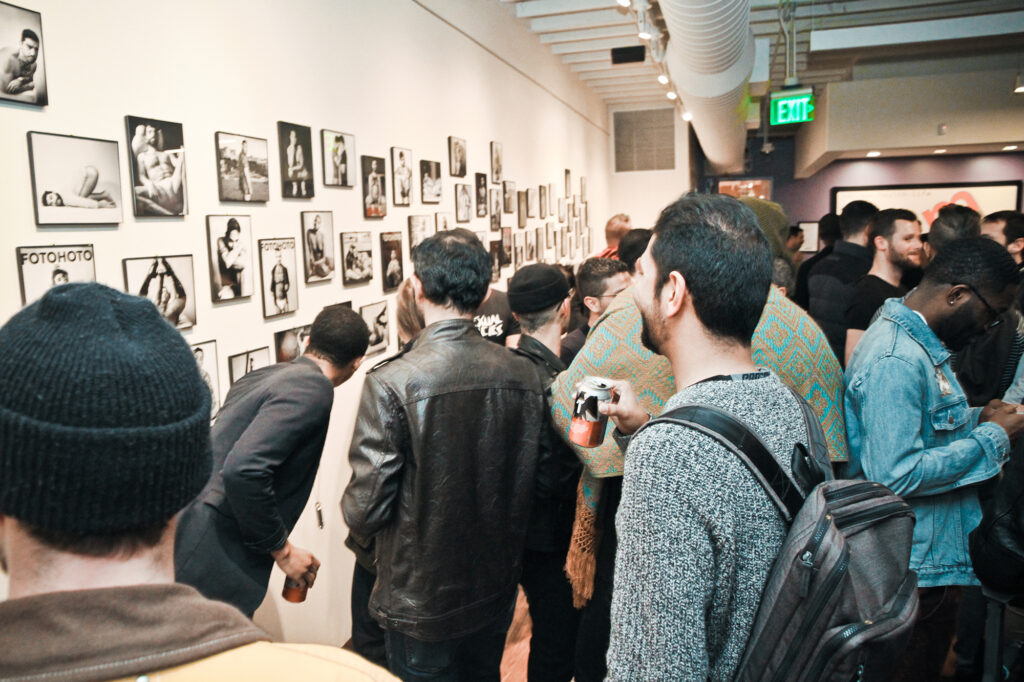
“I think 50% of people who are new to Strut just haven’t heard of it before. The other 50% may find some reason not to come to the Castro or think that it’s not the right neighborhood for them. So we’re helping give them a reason to come to this neighborhood, and to our health center, and learn what kinds of services, health resources, and events are here for them.”
Over the years, Porras-Hernandez has helped create on going performance series like Black Love, a show featuring Black artists and performers, co created by the artists Beatrice L. Thomas and Na’amen Gobert Tilahun; Trans Voices, a show featuring trans and non-binary artists, co created by the writers Julian Shendelman and Kay Nilsson; Parivar, a cultural experience for the south Asian community which was co created by the artists SNJV, Anjali Rimi, and writer Anand Vedawala; book release parties; art shows, and more.
Mostly, Porras-Hernandez said his goal is to make sure that performers and artists from different communities are empowered to use the event space and time to create the shows or experience that will best serve their communities.
“When we were working with Parivar, I asked the three people from that group to meet without me, because I’m not a south Asian person. I said, ‘Talk about what you would love to happen here!’ And they came up with a three day festival–one day to focus on family, one day to focus on sex and sexual health, and one day to focus on celebrating south Asian heritage. During the shows, they were able to talk about cultural issues, cultural shame, toxic masculinity, and their community–and none of it was through a white lens. It was really wonderful to see this community come together in this way.”
Editor’s note: Throughout 2022, we will continue to share the history of many more of our communities including people who use drugs, our dedicated volunteers, long-term survivors and other folks living with HIV, our Spanish-speaking and Latinx communities, and HIV activists.
Commemorating 40 years
In 2022, San Francisco AIDS Foundation marks 40 years of service to the community.
On this momentous occasion, we take a look back and share our storied history of leadership in HIV prevention, education, advocacy, and care. We celebrate the remarkable individuals at SFAF and in the community who have pushed forward innovation with compassion. We honor those we have lost to HIV along the way. We also reflect on the many ways our organization has grown and evolved to respond to the changing landscape of HIV and the changing needs of our community.
As we look back on our history, we approach the future with hope, and with a renewed sense of all that our passion and ingenuity can bring to enact positive change in our community. We will act in bold and brave ways to reach an end to the AIDS epidemic, and ensure that health justice is achieved for all of us living with or at risk for HIV.
After 40 years, we will not lose sight of our commitment to our community, and our vision for a brighter future.





